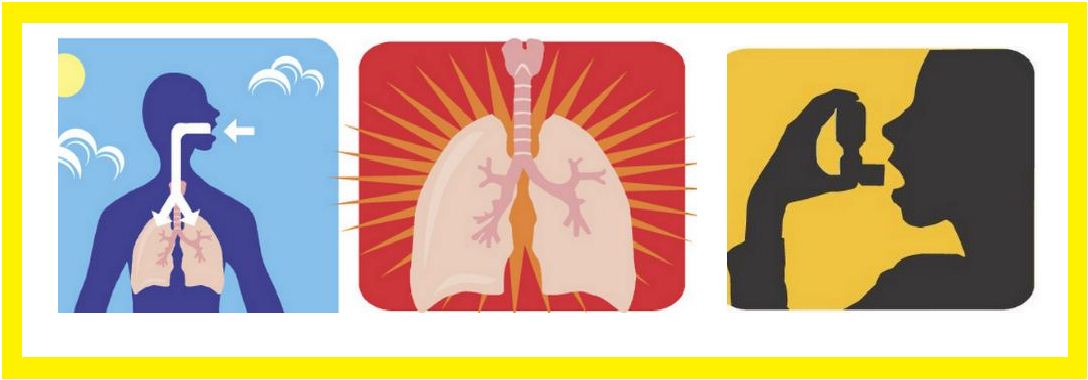Health Challenges Of Asthma Disease In Nigeria And How To Diagnose And Treat It

The prevalence of bronchial asthma cases in Nigeria has been on the rise, as much number of people suffering from the disease (i.e. asthma) is roughly between 7% - 18% of the overall population of the country.
As enormous as the country is in population wise, asthma prevalence rate is astronomically on the increase, despite recent advances in understanding and management of the illness in practice.
With the prevailing challenges confronting the management of asthma for the sufferers in Nigeria, which scores low in the areas of diagnosis, treatment and follow up, lack of proper diagnostic devices, high cost of drugs and lack of central medical guidelines in treatment of the illness further exacerbate the precarious medical situation in failure to arrest the control of symptom relief reduction and prevention of accelerated decline in bronchial asthma cases in the country.
Asthma is simply defined as a long-lasting problem in the tubes that transport air into the lungs, which can make breathing to be difficult. As these airways become narrower, air movement equally becomes difficult and this impediment can result to serious wheezing and breathlessness known as asthma flare-up or attack.
Typically, asthma develops mostly during childhood but can occur at any age and people have allergies and can also extend to a parent and a close family member, who are more vulnerable to asthma.
Signs and symptoms
The asthma patient(s) or sufferers will notice that their airways are always inflamed, as the airways become more swollen which can trigger the symptoms and the process which makes it very difficult for air to move in and out of the lungs, resulting in the following symptoms:
- Shortness of breath
- Gasping
- Chest tightness
- Coughing
- Wheezing, which are the typical signals of symptoms of asthma attack.
And these sudden symptoms can be life threatening as the sufferer is in the state of breathlessness to walk or talk, with the sudden appearance of blue coloration on the lips and finger nails, when the application of the rescue inhaler failed to perform, as the oxygen is being denied, which is the most critical peak of the attack which urgently required the professional attention of an allergist or immunologist to open the airways to activate a passage way to oxygen.
For many asthma patients, the timing of these symptoms is closely related to physical activity as some healthy people of persons can also develop asthma symptom when exercising.
This cannot deter us from engaging in exercise, which is an important way to stay healthy as it is necessary to develop a management plan with your physician to keep one’s symptom in check before, during or after the physical activity.
Causes of Asthma
It is noted that certain triggers can cause inflammation in airways to become worse, as the swelling makes the space inside to be smaller at the same time the body may produce more mucus that blocks those airways, thereby making the passage of air "in and out" of the lungs extremely difficult evidenced by the symptoms of wheezing and the struggle to breathe.
In addition, people who smoke or addicted to cigarette smoking are more vulnerable to asthma and passive smokers who mistakenly stay around the smokers are also likely to get asthma and the health issue of obesity (over weight) should not be taken lightly as the problem of overweight may be a likely contributor.
Treatment goal
The treatment goal for the illness is basically to achieve the overall clinical success on the symptoms - relief, future risks, improvement in activities and lung function for the sufferers.
Asthma treatment
As people with asthma are at the risk of developing complications from the respiratory infections like influenza and pneumonia, an immediate medical professional attention on treatment with the asthma medications can only save the situation and afford the patient the opportunity to live again a healthy and active life.
And two medical treatment approaches of short-term relief and long-term control are the most effective way to handle the treatment of asthma in patients and also the two basic medications involved in the treatment of asthma.
1. Steroids & Anti-Inflammatory Drugs: These life-saving medications are applied to prevent asthma attacks and function by slowing the production of mucus production in the airways by making the airways less sensitive and unable to react to asthma triggers that cause asthma symptoms.
And other anti-inflammatory drugs particularly the whaled steroids are the most important and ideal treatment for most people with asthma or suffering from asthma.
2. Bronchodilators: This is a short term relief medication applied to relieve the symptoms of asthma by relaxing the muscles that tighten around the airways making it possible to be free to function normally.
Rescue inhalers are used to quickly relieve the symptoms of asthma flare-up and also ideal for people with exercise induced asthma, preferably to be used prior to the activity. It is medically advised to be cautious on the use as it is not used as a daily treatment therapy of asthma.
It is also important to add that long lasting bronchodilators are sometimes used in combination with inhaled steroids for control of asthma symptoms.
Diagnostic measures/investigations
It is also necessary to carry out needful tests to help diagnose asthma by finding out the factors that seem to trigger symptoms or worsen it.
And physical examination is included as physician listen to breathing and looking for signs of asthma or allergies. In addition, lung function test is also important as spirometry check becomes handy to check how the lungs function and other tests may be requested by the physician.
These tests or investigation are necessary for the physician to work effectively and reduce the symptoms by improving the lung function.
Diagnosing asthma in children
Most children who have asthma develop initial symptoms before five years of age. It can be hard to diagnose as it is sometimes hard to differentiate symptoms of asthma from other childhood conditions, as the symptoms of asthma also manifest with other conditions.
A symptom of wheezing in a child as a result of cold or respiratory infection may not attain asthma at the age of six years, as a child may wheeze, as a result of small airways that become narrower during cold or respiratory infections but as the child grows the airways expands.
And it is always hard to run a lung function test in a child younger than five years, but a diagnosis is limited only to children’s medical histories, prevailing signs and symptoms and physical examination.
It is encouraging to maintain that asthma symptoms can be controlled with effective treatment and management plan, which involves intake of prescribed medications as directed by physician or immunologist and also learning by implementing the rules to avoid triggers that cause asthma symptoms, as immunologists and allergists are best suited to handle and manage the illness.
And the determined efforts of the Nigerian thoracic society in leading the drive for the achievement of better quality healthy and active life for the sufferers and Government role are also needed to chart for a better health living for the sufferers.




